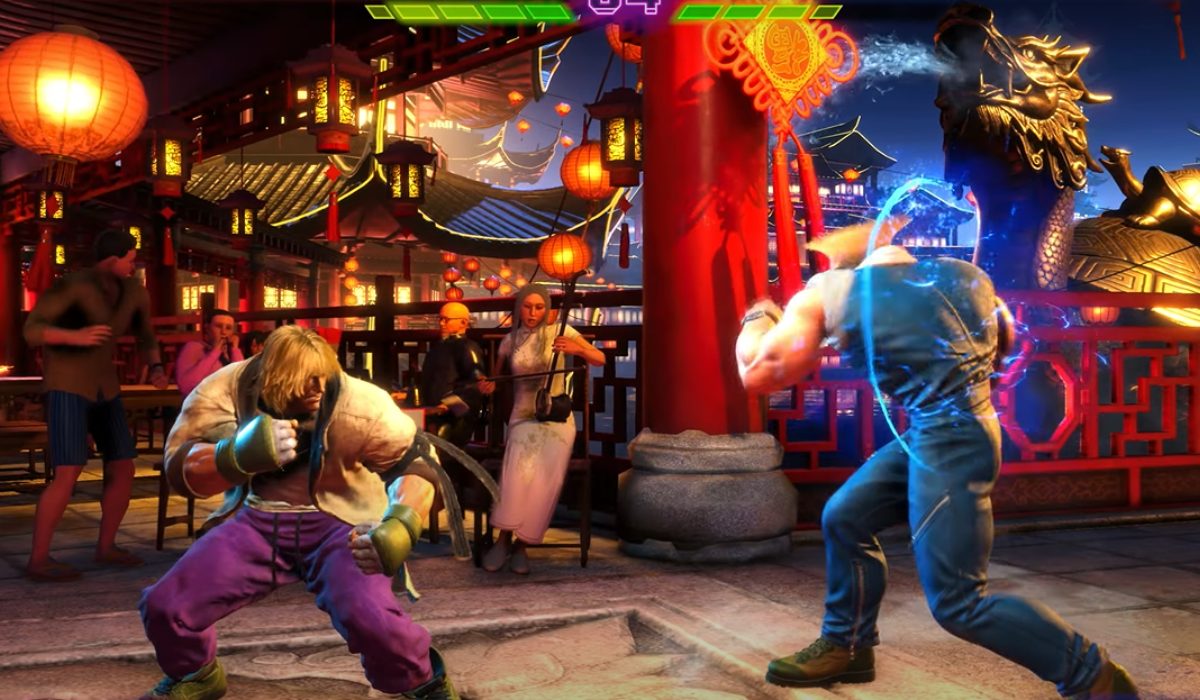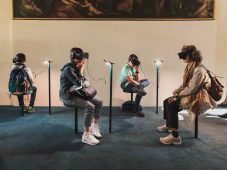Introduction
Online gaming has taken the world by storm, captivating millions of players with its immersive and competitive gameplay. From virtual battlefields to fantasy realms, the digital landscape has become a battleground for gamers to showcase their skills and engage in epic encounters. But have you ever wondered what these intense gaming fights would look like in reality?
In this article, we will delve into the realm of imagination and envision how online gaming fights would play out outside of the digital world. Get ready to embark on a journey where power-ups, weapons, and intense match-ups come to life.
As we explore this alternate reality, we will consider the physical versus digital battle royale, the potential for real-life power-ups and weapons, and even the prospect of offline gaming championships. Along the way, we will also examine the transformational effects of virtual reality gaming, the feasibility of epic boss battles in real life, and the intense training regimens of professional gamers.
So buckle up, and let’s take a plunge into the world where pixels meet flesh and blood, where gaming fights transcend the boundaries of the virtual and merge with the tangible.
The Physical vs. Digital Battle Royale
In the realm of online gaming, players engage in intense battles using their virtual avatars. But what if these virtual clashes were translated into the real world? Picture a massive arena where gamers physically embody their in-game characters, maneuvering through obstacles, and executing moves in real-time.
Imagine a Battle Royale scenario where players gather on a vast battleground, armed with their weapons and abilities. They would engage in a frenetic fight, combining their physical agility with their gaming skills to emerge victorious.
This crossover between the physical and digital realms would introduce a whole new level of excitement and intensity. Adrenaline would surge through the participants as they face the challenge of navigating the battlefield and outsmarting their opponents in real-time.
It’s fascinating to envision the strategies and tactics players would employ in this real-life version of a Battle Royale. Would they rely on their gaming experience and reflexes to outsmart their opponents? Or would physical strength and agility take precedence over digital prowess?
However, it’s important to consider the limitations and risks associated with such a concept. The physical nature of this battle would undoubtedly expose participants to potential injuries. Safety protocols, equipment, and controlled environments would need to be meticulously implemented to ensure the well-being of the players.
The Physical vs. Digital Battle Royale would not only provide a unique spectacle for spectators but also offer gamers a chance to physically challenge themselves and put their skills to the ultimate test. It would blur the line between the virtual and the real, creating an unforgettable experience that bridges the gap between gaming and reality.
Power-Ups and Weapons in Real Life
Power-ups and weapons are integral components of online gaming, providing players with advantages and tools to defeat their opponents. But wouldn’t it be exhilarating to see these virtual enhancements come to life?
In our imagined reality, power-ups would manifest as physical objects that players could strategically utilize. Imagine picking up a speed boost and feeling the rush as you sprint faster than ever before. Or imagine equipping a shield that envelops you in an impenetrable force field, protecting you from harm.
Weapons, too, would transform into tangible assets in this real-life gaming scenario. From explosive projectiles to futuristic energy weapons, players would wield these weapons in their hands, feeling the weight and impact with every strike.
Of course, safety measures would need to be in place to ensure that these weapons and power-ups do not cause harm outside of the gaming arena. Participants would engage in intense battles, knowing that each power-up and weapon they acquire could be the key to victory.
This transition from virtual power-ups and weapons to their physical counterparts would add an extra layer of excitement and immersion to the gaming experience. It would bring players closer to the action and allow them to truly feel the impact of their abilities and arsenal.
Imagine the strategic choices players would make when faced with a range of power-ups and weapon options. Would they prioritize offensive capabilities, or would they lean towards defensive tools to ensure their survival? These decisions, combined with the physicality of the battles, would create a new level of intensity and excitement.
In this melding of the virtual and the real, gamers would have the opportunity to experience the thrill of power-ups and weapons on a whole new level. It would blur the boundaries between imagination and reality, giving rise to a gaming experience that is truly immersive and memorable.
The Grand Tournament: Offline Gaming Championships
While online gaming tournaments have gained immense popularity, with players competing against each other from all corners of the globe, imagine the spectacle of an offline gaming championship. In this alternate reality, gaming enthusiasts would gather in massive arenas to witness the clash of the best players in the world.
The atmosphere would be electric, with roaring crowds cheering for their favorite teams or players. Spectators would experience the thrill firsthand, surrounded by the energy and passion of fellow gaming fans.
Offline gaming championships would bring a new dimension to the gaming landscape. The intense battles that unfold on screens would be recreated in real life, allowing players to physically showcase their skills and abilities. It would add a dynamic element to the competition, as players would need to adapt their strategies to the ever-changing environment.
These championships would not be limited to a single game. Instead, a variety of gaming genres and titles would be represented, from first-person shooters to strategy games and beyond. Each championship would be a celebration of the diverse gaming community, highlighting the talent and dedication of players in different genres.
The offline gaming championships would also feature engaging side events and activities. Exhibitions showcasing the latest gaming technologies, meet-and-greets with professional players, and interactive experiences for attendees would further enhance the overall spectacle.
Not only would offline gaming championships provide a thrilling experience for spectators, but they would also offer a platform for aspiring gamers to showcase their skills. It would inspire a new generation of gamers to hone their abilities and aspire to compete on the grand stage.
Offline gaming championships would be a testament to the ever-growing influence of gaming in our society. They would unite gaming enthusiasts, forge new friendships, and create unforgettable moments that would be cherished by players and spectators alike.
The Ultimate Showdown: Pro Gamers vs. Non-Gamers
Imagine a clash between professional gamers, masters of the virtual realm, and non-gamers, individuals who have little to no experience in gaming. In this ultimate showdown, the two worlds collide, and the question arises: who would come out on top?
Professional gamers have honed their skills through countless hours of practice and competition. Their reflexes, strategic thinking, and game knowledge are finely tuned, allowing them to excel in the digital realm. On the other hand, non-gamers bring a fresh perspective, relying on their natural abilities and ingenuity to navigate challenges.
In this epic battle, professional gamers would have the advantage of familiarity with gaming mechanics and strategies. They would effortlessly execute complex maneuvers and make lightning-fast decisions, leveraging their years of experience and immersion in the gaming culture.
However, non-gamers would bring an unpredictable and unconventional approach to the showdown. They would rely on their intuition, problem-solving skills, and adaptability. Their lack of gaming experience may work to their advantage, as they approach the challenges with a fresh set of eyes and a willingness to think outside the box.
The clash between pro gamers and non-gamers would go beyond the realms of gaming expertise. It would test the limits of different skill sets and mindsets, showcasing the value of both experience and creativity.
Ultimately, the outcome of this ultimate showdown would depend on the specific tasks and challenges presented. Certain tasks may favor the strategic thinking and quick reflexes of professional gamers, while others may require the ingenuity and adaptability of non-gamers.
Regardless of the outcome, this clash would be an opportunity to celebrate the diverse talents and abilities that exist in our world. It would shed light on the unique perspectives that professional gamers and non-gamers bring to the table, sparking conversations and challenging preconceived notions.
Whether pro gamers reign supreme or non-gamers rise to unexpected heights, the ultimate showdown would serve as a reminder that expertise can come in various forms and that gaming, like any other skill, requires dedication, practice, and a willingness to continuously evolve.
How VR Gaming Transforms Fighting Games
Virtual reality (VR) has revolutionized the gaming industry, immersing players in a whole new level of interactive experiences. When it comes to fighting games, VR technology has the power to completely transform the way we engage in virtual combat.
With VR gaming, players can step into the shoes of their in-game characters, feeling every punch, kick, and dodge as if they were in the midst of the battle. The immersive nature of VR allows for a deeper connection between the player and the game, creating a sense of presence and intensity like never before.
In VR fighting games, players can utilize their own physical movements to execute attacks and defenses. They can throw punches, kick, and block just as they would in real life, translating their real-time actions into in-game maneuvers.
This level of physicality adds a whole new dimension to the gameplay. Players must rely on their reflexes and agility, moving their bodies and reacting instinctively to their opponents’ attacks. It creates a more dynamic and engaging experience, as they must use their own physical abilities and spatial awareness to overcome their opponents.
The immersive nature of VR also enhances the strategic aspect of fighting games. Players must analyze their surroundings, anticipate their opponents’ moves, and execute precise actions to gain the upper hand. It demands a higher level of focus and mental acuity, as players must adapt to the immersive virtual environment while formulating effective strategies.
Furthermore, VR technology allows for realistic representations of different fighting styles and techniques. Players can learn and practice various martial arts moves, honing their skills and mastering different fighting styles within the game. This not only offers a unique way to experience different combat styles but also presents an opportunity for players to learn and appreciate the intricacies of martial arts.
As VR technology continues to advance, the potential for even more realistic and immersive experiences in fighting games grows. The inclusion of haptic feedback systems, motion tracking, and detailed visuals can further enhance the sense of realism, making the gameplay feel even more tangible and exhilarating.
VR gaming has truly transformed fighting games, elevating the intensity, immersion, and physicality of the experience. It opens up new avenues for players to engage with virtual combat, offering a thrilling and realistic alternative to traditional gaming platforms.
Epic Boss Battles: Can They be Replicated in Real Life?
One of the most thrilling aspects of gaming is facing off against powerful and awe-inspiring boss battles. These encounters often test players’ skills, strategy, and perseverance. But could these epic boss battles be replicated in real life, providing a similar level of challenge and excitement?
Replicating boss battles in real life poses numerous challenges. The fantastical abilities and larger-than-life characteristics of video game bosses would be difficult, if not impossible, to recreate. However, there are certain elements of these battles that could be translated into real-life scenarios.
For example, the strategic aspect of boss battles could be implemented in physical challenges. Players would need to analyze the strengths and weaknesses of the “boss,” adapt their tactics on the fly, and discover its vulnerabilities to achieve victory. This would require critical thinking, problem-solving, and teamwork.
Incorporating interactive environments could also add to the excitement and intensity of real-life boss battles. Just as players in a video game utilize their surroundings to gain an advantage, real-life battles could include obstacles, traps, and interactive elements that players must navigate and leverage to defeat the boss.
The physicality of real-life boss battles would add another layer of challenge. Players would need to rely on their physical abilities, endurance, and agility to overcome the boss’s attacks and defenses. These battles could push players to their limits, testing their physical prowess and mental resilience.
However, it is important to consider the safety implications when replicating boss battles in real life. Intensive physical challenges must be carefully designed and supervised to ensure the well-being of participants. Protective gear and safety measures would be essential to minimize the risk of injuries.
While true replication of epic boss battles may be impractical, real-life adaptations can still capture the essence of these encounters. They can provide unique opportunities for players to immerse themselves in challenging scenarios, pushing their limits, and experiencing the thrill of facing formidable adversaries.
Ultimately, real-life boss battles may not exactly replicate the fantastical elements of video games, but they can incorporate strategic thinking, physical challenges, and interactive environments to create thrilling and memorable experiences.
The Road to Glory: Training Regimens of Pro Gamers
Behind every successful professional gamer lies a rigorous and disciplined training regimen. The road to glory is paved with countless hours of practice, dedication, and perseverance. Pro gamers understand that their skills must be constantly sharpened in order to compete at the highest level.
Training regimens of pro gamers often involve a combination of individual practice, team scrimmages, studying game strategies, and physical exercise. These elements work together to improve various aspects of their gameplay and overall performance.
Individual practice is a cornerstone of a pro gamer’s training routine. They spend countless hours honing their skills, perfecting their reflexes, and mastering the intricacies of the game. This includes practicing specific techniques, improving reaction times, and developing their strategic thinking.
Team scrimmages play a crucial role in pro gamers’ development. They practice and compete with their teammates, refining their teamwork, communication, and coordination. This collaborative training allows them to understand each other’s playing styles, anticipate their teammates’ moves, and synchronize their strategies.
Furthermore, pro gamers devote a significant amount of time to studying and analyzing game strategies. They review gameplay footage, study opponents’ tactics, and analyze their own performances to identify areas of improvement. This analytical approach helps them gain a deeper understanding of the game and develop counter-strategies to outwit their opponents.
Physical exercise is increasingly being recognized as an important component of a pro gamer’s training regimen. Engaging in regular exercise routines helps improve focus, endurance, and overall well-being. Pro gamers understand that maintaining a healthy body contributes to optimal performance in high-pressure gaming environments.
In addition to the physical and tactical aspects, mental preparation is crucial for pro gamers. They practice mindfulness techniques, such as meditation and visualization, to enhance their focus and concentration during intense gameplay. They also develop mental resilience to handle the stress and pressure of competitive gaming.
The road to glory for pro gamers is not without its challenges. It requires significant dedication, sacrifice, and a relentless drive for improvement. Pro gamers understand that just like any other sport or profession, consistent and disciplined training is vital to stay at the top of their game.
As the esports industry continues to grow, professional gaming is becoming more competitive than ever. Aspiring pro gamers must invest time and effort into their training regimens to carve their path to success and stand out among the best.
The training regimens of pro gamers exemplify the commitment and passion required to excel in the world of competitive gaming. Their dedication to continuous improvement and the willingness to push their limits set them apart on their journey to achieving greatness.
The Gamer’s Arsenal: Real-Life Gaming Accessories
When it comes to gaming, having the right accessories can greatly enhance the gaming experience and give players a competitive edge. While many gaming accessories exist in the virtual world, let’s explore how these accessories could be translated into real-life counterparts.
One essential accessory is the gaming headset. In real life, a high-quality headset would provide clear audio and immersive sound effects, allowing players to fully immerse themselves in the game world. The ability to communicate with teammates and hear enemy movements would give players a tactical advantage.
The gaming controller is another vital accessory. In real life, a responsive and ergonomic controller would allow for precise movements and quick reactions. Vibration feedback would add a tactile element, enhancing the overall gaming experience and increasing immersion.
Real-life gaming accessories could also extend to physical peripherals. For example, motion-sensing devices, similar to those used in virtual reality gaming, could replicate real-life movements within the game. Players could dodge, swing, and aim with their bodies, making the gameplay more dynamic and physically engaging.
Imagining a real-life gaming experience also raises the possibility of specialized equipment. For example, gaming gloves could enhance sensitivity and precision, allowing players to execute complex maneuvers with ease. Gaming chairs with integrated rumble features could emulate the in-game vibrations, immersing players further into the action.
The incorporation of augmented reality (AR) technology could introduce innovative gaming accessories. AR glasses would overlay virtual elements onto the physical world, creating a truly interactive and immersive gaming experience. The glasses could display crucial in-game information, enhance visual effects, and even project virtual opponents into the real world.
While implementing real-life gaming accessories would require careful design and engineering, they have the potential to revolutionize the way we play games. These accessories could amplify the sensory experience, providing a more immersive and realistic gaming environment.
In the quest for the ultimate gaming experience, the development of real-life gaming accessories holds great promise. They could bridge the gap between the virtual and physical realms, bringing game elements into our tangible world and elevating the gaming experience to new heights.
Conclusion
Exploring the concept of what online gaming fights would look like in reality opens up a world of imagination and possibilities. While the exact replication of virtual battles may be challenging, there are aspects that can be translated into real-life scenarios, providing exciting and immersive experiences.
The physical vs. digital battle royale would be a spectacle of skill, strategy, and physical prowess. Power-ups and weapons, when transformed into real-life counterparts, would add a tangible element to the gaming experience.
The idea of offline gaming championships brings together passionate gamers and offers a platform for showcasing talent and skill across various gaming genres. The clash between pro gamers and non-gamers highlights the diverse ways in which individuals can approach challenges and succeed.
VR gaming transforms fighting games, enabling players to engage physically and mentally in virtual combat, while epic boss battles, although challenging to replicate, can still capture the essence of intense encounters.
The dedication and discipline of pro gamers’ training regimens showcase the commitment required to excel in the competitive gaming industry. Real-life gaming accessories, such as headsets, controllers, and motion sensors, further enhance the gaming experience.
While the potential for real-life gaming scenarios is exciting, it is worth considering the safety implications and technological advancements required to bring these ideas to fruition.
In a world where technology continues to evolve and the gaming industry pushes boundaries, the exploration of what online gaming fights would look like in reality serves as a testament to the incredible possibilities and immersive experiences that gaming can offer.
So let your imagination run wild as you envision the convergence of the digital and physical worlds, where gaming fights transcend pixels and come to life in thrilling and unforgettable ways.

























